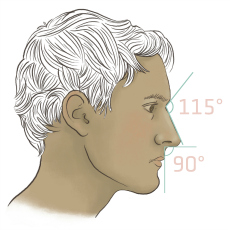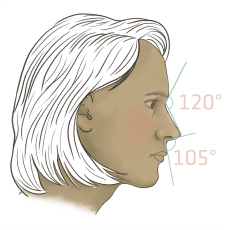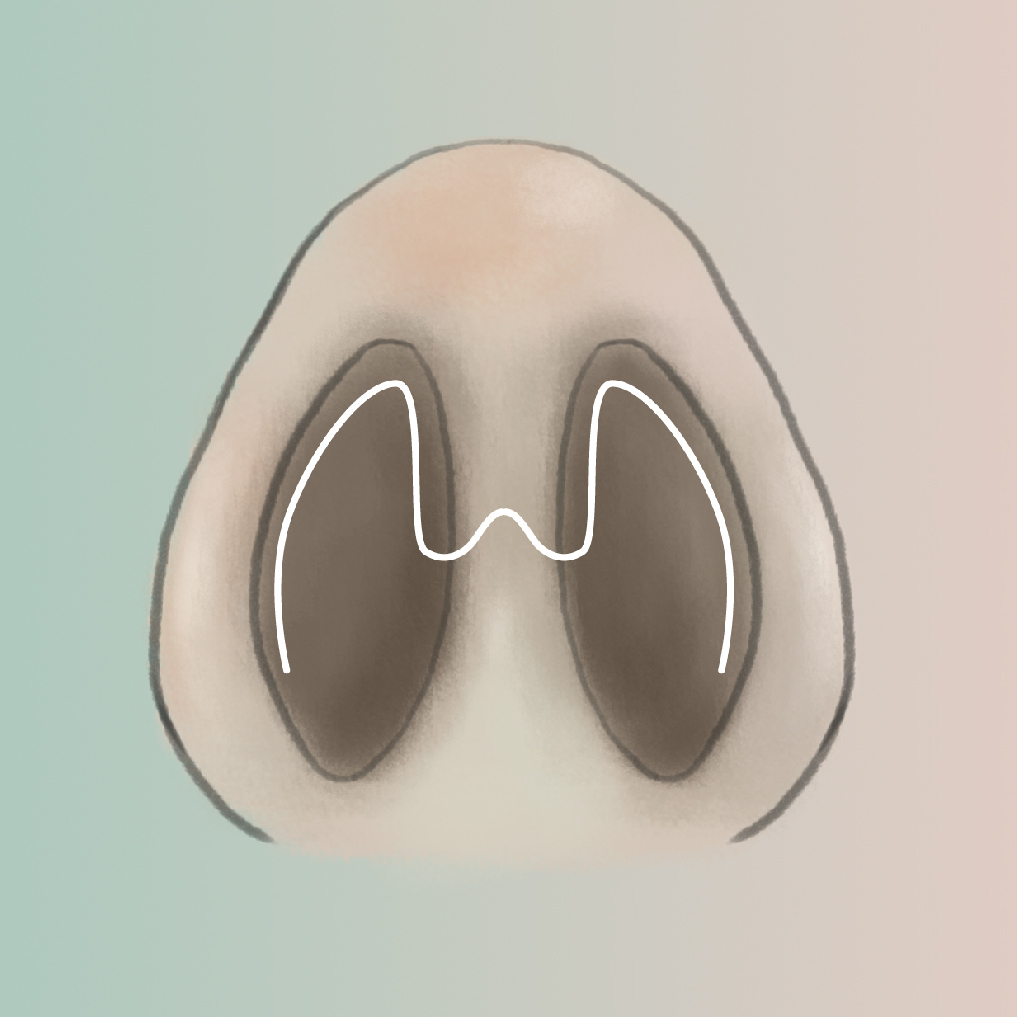Nose feminization surgery
Table of contents:
Aside from the trachea shave, nose feminization is probably the most common Facial Feminization Surgery procedure. The nose is the most prominent feature of the face. Many transwomen reckon that nasal refinement can create marked improvements in their female facial appearance. It tends to make the eyes look larger, bring out the cheekbones and it adds delicacy to the overall facial impression.
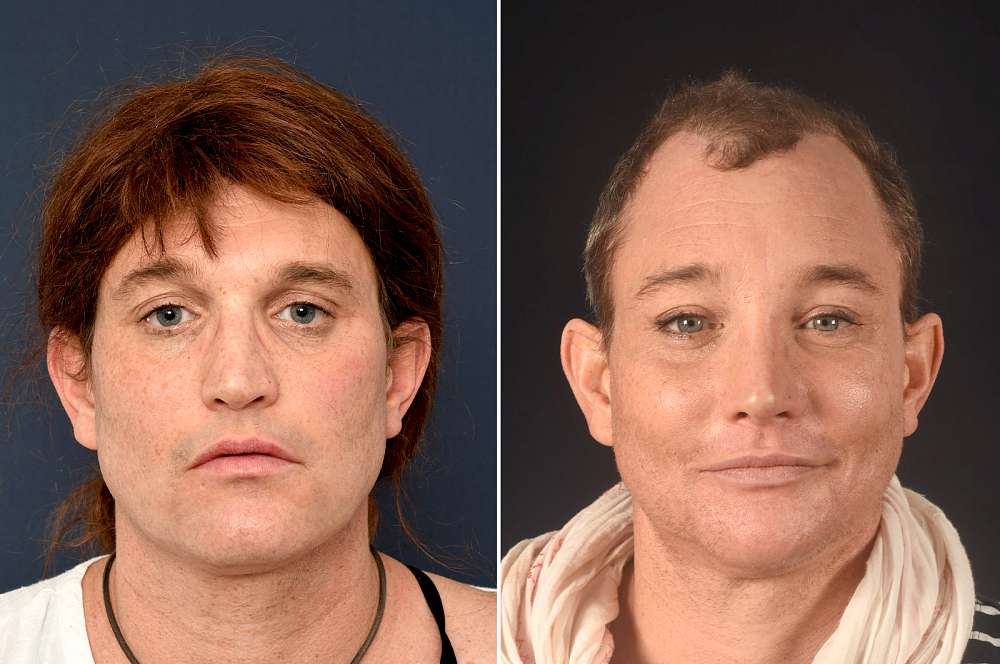



















Gender of the nose
Male nose
| Female nose
|
Male noses are usually larger than those of women, with a broader nasal bone. Men more often have a nasal hump. Usually, beautiful female noses are smaller than those of men, in all aspects. They tend to be narrow and straight or to have a gentle curvature like a slide. The angle between the male forehead and nose is sharper than in women and the angle between the nose and lip is also smaller (more pointing upwards). The angle between the nose and the lip is bigger in women than in men. Women´s nostrils are usually smaller as well.
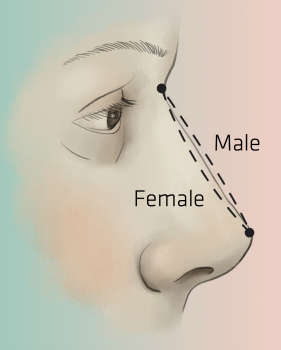
Nose feminization
Standard rhinoplasty techniques can be used to make the nose smaller (or to reshape it) and to give it a clear feminine outline and proportions. It needs to be in harmony with the rest of the face. For nose feminization, generally the dorsum and tip of the nose need to be made smaller and the tip lifted. Correcting the frontal bossing will improve the angle between the nose and the forehead. If one has thin skin, a significant reduction can generally be completed. If the skin is quite thick (as is often the case in males), the contour can still be markedly improved, but there may be a definite limitation to the possible size reduction. However, contour changing alone greatly feminizes the basic nasal appearance.
Procedure
- General anesthesia—Rhinoplasties for nose feminization are usually done under general anesthesia. In certain minor cases, local anesthesia and sedation may be used. The operation generally lasts between one and two hours.
- Incision—For almost all nose feminization rhinoplasties we prefer the ‘open method’ because it gives the surgeon more operational space. In the ‘open’ approach, one small incision is made outside the nose across the columella (the skin between the nostrils). After a couple of months, the scar is generally extremely difficult to see.
- The real job—According to your individual needs, the following actions may be executed during the procedure:
- Giving support to the tip—A cartilage ‘strut’ is taken from the septum or ear and sutured into the columella (part of the nose between the nostrils) to give support to the nasal tip.
- Refining the tip— Sutures are placed to achieve the refinement or the ‘narrowing’ of the nasal tip.
- Shaping the profile—The bone-cartilage hump is removed. A surgical file or rasp is commonly used to smooth the bony hump, in order to achieve more precise results.
- Reconstruction rhinoplasty—In case the nose structurally lacks cartilage to give shape to the tip, the wings or the vault of the nose, cartilage may be taken from the septum, or ear(s). This will then be reshaped and sutured back into the part of the nose that needed support. If larger volumes are needed to augment the dorsum, a roll of Mersilene mesh is a good option.
- Narrowing the nasal bone—If the bridge of the nose is wide, it can be narrowed by fracturing the nasal bone on each side and moving it closer to the center.
- Narrowing the nostrils—The volume of the nostrils can be reduced by an alar base excision (nasal base narrowing).
- Sutures—Small sutures will be used to close the incisions. The sutures are not absorbable and have to be removed 8 days after the surgery.
Recovery
- Vaseline—No crusts may form in the nose as this is not good for healing. The crusts have to be removed. Applying vaseline 3 times a day helps soften the crusts so you can remove them gently (see video below).
- Breathing—Most people find it very difficult that they're not able to breathe through their noses after rhinoplasty. During your preoperative consultation, we will give you some nose drops to open up the nose after surgery.
- Stitches—The stitches underneath the nose will be removed by Dr Bart van de Ven 7 days after the nose feminization surgery.
- Bleeding—Some sporadic bleeding could be expected during the first couple of weeks, which is normal and should not be cause for concern.
- Bruising—Most people get bruising around the eyes and cheeks. The bruises under the eyes will intensify during two or three days before they begin to vanish. 15 days later, only you and your surgeon will be able to notice any traces of the surgery.
- Appearance—Your nose will regain its normal appearance very soon, but you can only fully appreciate the definitive results of the rhinoplasty after six months. The tip is the area that takes the longest to acquire its new shape.
Frequently asked questions
What does this procedure cost?
You can find estimated prices here, after your consultation you will be informed of the exact prices of your operation. Prices are average and may vary depending on the exact treatment.
There are 3 options to receive a financial and operative proposal. You can either send us pictures and receive a quote and an FFS simulation, or you can book a Skype or a live consultation with Dr Bart van de Ven during which you will also receive a quote and FFS simulation. Click here if you want to get a general idea of FFS prices.
What happens if there are complications after the procedure and is this covered?
We will correct the complication if surgically possible, without charging any surgical fees. Hospital, material and traveling costs are for the expense of the patient.
Can I get this surgery if I’m a cis woman?
Yes, of course. We perform Facial Feminization Surgery on all women. Every woman is welcome at our clinic!
How long does it take for the final result to be visible and the bruises to disappear completely?
Recovery looks different for every patient, but bruising usually disappears after two to four weeks. The final result can be visible after a few months, but it may also take longer than a year. All information on recovering from FFS can be found on our recovery page.
Could breathing be more difficult after a reduction rhinoplasty?
In a normal nose, the respiratory route becomes critical at one specific structural point which is the internal valve. By the use of spreader flaps or spreader grafts, Dr van de Ven will make sure that the nose doesn’t become smaller at that specific point.
How often is revision surgery necessary after a rhinoplasty?
Rhinoplasty is considered to be an operation with high risks, primarily because of the limited predictability of the aesthetic result. Postoperative deformities are considered the main risks of rhinoplasty, causing revision surgery in 5% to 15% of the cases. What are the reasons? A perfect result immediately after surgery may be totally different one year later. Limited predictability is mainly due to the dynamics of the healing process. Many different types of tissues are involved: bone, cartilage, mucosa, skin, fat, fascia, muscles, nerves, vessels, perichondrium and periosteum. The individual reactions of these tissues are not always under the control of the surgeon. This is especially true for cartilage, the main supporting structure of the nose. The risks for rhinoplasty-complications can be reduced with increasing experience. A prerequisite is continuing education and an earnest distinction between a complication and a mistake. Dr Bart van de Ven has built up a decent experience with noses during his career. That’s why he has relatively very few complications.
How long should I wait to see the final result of a rhinoplasty?
After a rhinoplasty you have to be really patient. During the first 3 months it can be very swollen. Especially if you have a thick type of skin it can take more than a year for all the swelling to disappear. The nose can continue to change until 1–2 years after surgery.
Would it help my nose swelling if I put some tape across it?
The tape helps partly to avoid the swelling from forming. Once the swelling is there however, the tape will not make it disappear. All you can do is wait.
What do I have to do if an unpleasant smell eminates from nose after surgery?
Follow all postoperative instructions and make sure to rinse your nose thoroughly and regularly with lukewarm water.
We are doing our very best to keep this information up-to-date. In case you see anything that no longer seems accurate, or in case you have a question, please fill out the form below!

